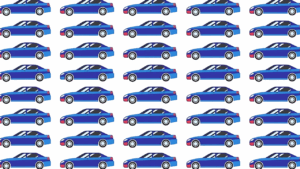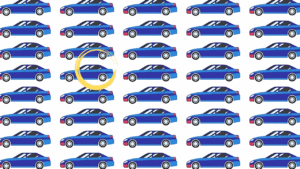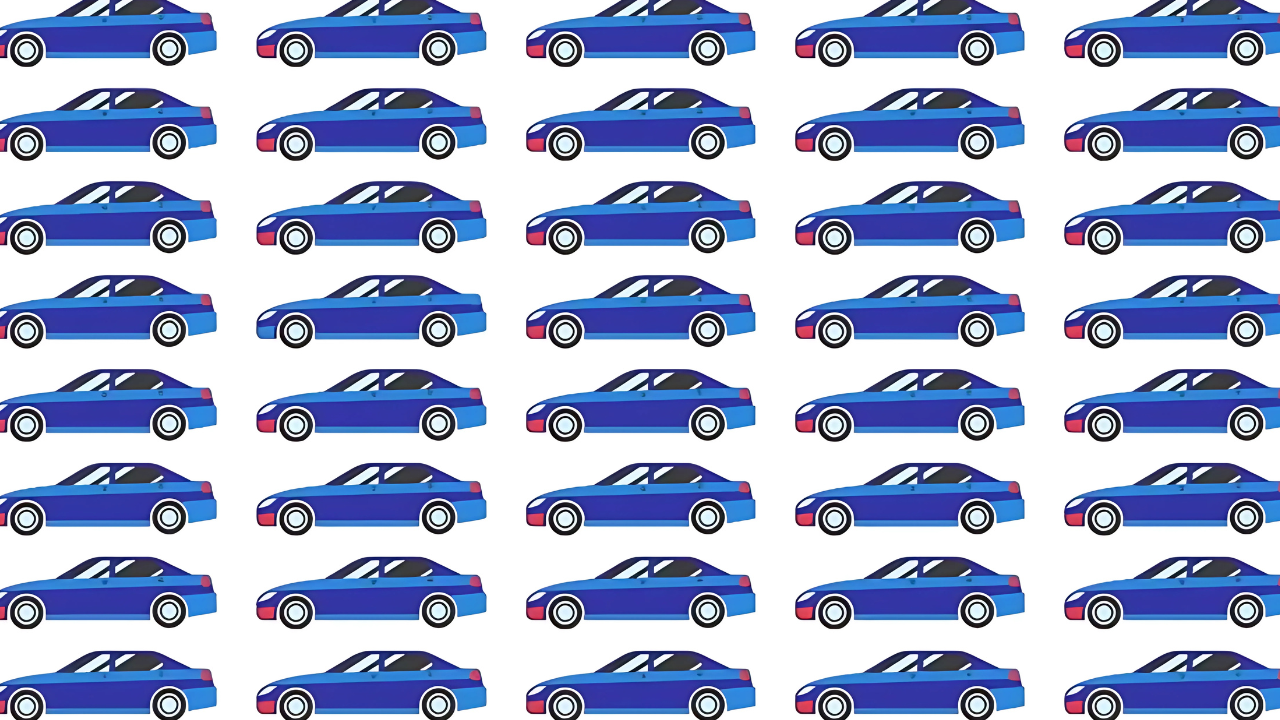Optical illusions have a unique way of captivating our minds, blending art, psychology, and neuroscience to create puzzles that challenge our perception. The viral brain teaser, “Find the Strange Blue Car in 25 Seconds,” has taken the internet by storm, daring participants to identify a single blue car that differs from a grid of seemingly identical vehicles. With only 25 seconds to find the anomaly, this challenge tests your observation skills, focus, and mental agility, claiming that only the top 1% of people can succeed within the time limit. Popularized by outlets like The US Sun and IndiaTimes, this puzzle has sparked global excitement, with social media users sharing their times and strategies. In this article, we explore the mechanics of the illusion, why it’s so challenging, its cognitive benefits, tips to conquer it, and how it compares to other optical illusions, all while celebrating the thrill of visual puzzles.

The Strange Blue Car Challenge: What’s the Puzzle?
The “Find the Strange Blue Car” optical illusion, as described by The US Sun and IndiaTimes, presents a grid of 40 cars, typically arranged in eight rows with five columns. Each car appears nearly identical, featuring a light blue body, a dark blue horizontal stripe, and red bumpers. However, one car stands out with a subtle difference—perhaps a missing red bumper, a different tail light, or a slight variation in the stripe’s design. The challenge is to spot this “strange” car within 25 seconds, a task that demands sharp visual discrimination and quick decision-making. According to IndiaTimes, the odd car is often located in the second column from the left, fourth car down from the top, with a missing red bumper or tail light distinguishing it from the others.
This puzzle’s difficulty lies in its visual uniformity. The repetitive blue color scheme and similar car designs trick the brain into assuming all cars are identical, a phenomenon known as perceptual grouping. The 25-second time limit adds pressure, forcing participants to balance speed and accuracy. For those who succeed, it’s a badge of honor, placing them in the elusive “top 1%” of visual acuity and cognitive prowess.
Why Optical Illusions Are So Challenging
Optical illusions exploit the brain’s shortcuts in processing visual information. Our visual system is designed to recognize patterns quickly, often grouping similar objects to simplify complex scenes. In the strange blue car challenge, the uniform color and design of the cars cause the brain to overlook subtle differences, making the odd car hard to spot. This is compounded by the time constraint, which triggers a stress response that can impair focus and increase errors.
The challenge engages multiple brain regions:
-
Visual Cortex: Processes shapes, colors, and patterns, struggling to isolate the anomaly amidst repetition.
-
Prefrontal Cortex: Manages attention and decision-making, critical for staying focused under pressure.
-
Parietal Cortex: Aids in spatial navigation, helping you scan the grid systematically.
The interplay of these regions under a tight deadline makes the puzzle both mentally taxing and rewarding. As Jagran Josh notes, such brain teasers test not just vision but also creativity and logical reasoning, requiring an “unparallel mindset” to succeed.
Cognitive Benefits of Solving Optical Illusions
Engaging with optical illusions offers significant cognitive advantages, backed by research on brain teasers. Regularly solving puzzles like the strange blue car challenge can enhance:
-
Observation Skills: Training your brain to notice subtle differences improves attention to detail, useful in tasks like proofreading or quality control.
-
Concentration: The need to focus under time pressure strengthens your ability to block distractions, boosting sustained attention.
-
Problem-Solving: Illusions encourage creative thinking, as you must look beyond obvious patterns to find the anomaly.
-
Cognitive Flexibility: Switching perspectives to identify differences hones mental agility, aiding adaptability in complex tasks.
-
Mood and Stress Relief: Solving puzzles can be meditative, offering a mental break and improving mood, as noted by Jagran Josh.
For those who spot the strange car in 25 seconds, it’s a sign of exceptional visual processing and high IQ, as the task demands rapid pattern recognition and decision-making. Even unsuccessful attempts improve cognitive skills, making it a valuable mental exercise.
Strategies to Spot the Strange Blue Car
To conquer this illusion, a strategic approach is essential. Here are practical tips to improve your chances:
-
Divide the Grid: Break the 8×5 grid into smaller sections (e.g., quadrants or rows) and scan each systematically to avoid visual overload.
-
Focus on Key Features: Look for specific differences, such as a missing red bumper, altered tail light, or stripe variation. The US Sun highlights the missing red bumper as a common clue.
-
Use Peripheral Vision: Instead of fixating on one car, sweep the grid broadly to let anomalies stand out in your peripheral field.
-
Stay Calm: The 25-second limit can induce panic, so take a deep breath to maintain focus and clarity.
-
Practice Regularly: Engage with similar “spot the difference” puzzles to train your brain for faster anomaly detection.
If you’re struggling, IndiaTimes suggests focusing on the second column from the left, fourth car down, where the odd car often lacks a red bumper or tail light. Checking solution images on platforms can confirm your find.

Comparison with Other Optical Illusions
The strange blue car challenge is part of a family of “spot the difference” illusions, each testing unique cognitive skills. Below is a table comparing it to other popular puzzles:
|
Puzzle |
Description |
Time Limit |
Skill Tested |
Difficulty |
|---|---|---|---|---|
|
Strange Blue Car Challenge |
Spot a different blue car in an 8×5 grid. |
25 seconds |
Visual discrimination |
Hard |
|
Hidden Number (94 among 49s) |
Find a number like 94 in a grid of 49s. |
7 seconds |
Pattern recognition |
Hard |
|
Hidden Animal (Pig among Birds) |
Spot a pig among similar animals. |
13 seconds |
Attention to detail |
Moderate |
|
Car Key Illusion |
Find a car key among cars in a grid. |
10 seconds |
Visual acuity |
Moderate |
|
Flat Tyre Challenge |
Spot a flat tyre among various tyres. |
7 seconds |
Rapid decision-making |
Moderate |
The strange blue car challenge stands out for its larger grid and longer time limit, balancing difficulty with accessibility compared to faster-paced puzzles like the flat tyre challenge.
The Global Appeal of Optical Illusions
Optical illusions have surged in popularity, particularly on platforms like X, where users share their solving times and challenge friends, fostering a sense of community. The strange blue car puzzle’s 25-second limit makes it ideal for quick mental breaks, while its claim of identifying the “top 1%” adds competitive allure. As The US Sun notes, the puzzle’s viral nature stems from its ability to engage both casual solvers and puzzle enthusiasts.
The challenge’s accessibility—no special tools required, just sharp eyes—makes it universally appealing. Its vibrant blue cars and clear objective draw in participants of all ages, while the satisfaction of spotting the odd car fuels social media engagement. Posts on X highlight users debating strategies, from scanning rows to focusing on bumpers, amplifying the puzzle’s reach.
The Science and Art of Optical Illusions
The strange blue car illusion combines art and science. The uniform blue color scheme and repetitive design are deliberate, leveraging principles of visual perception to create confusion. The subtle difference in the odd car—often a missing bumper or tail light—requires the brain to override its natural tendency to group similar objects. This mirrors other illusions, like the hidden number puzzle, where small variations challenge pattern recognition.
From a neuroscience perspective, solving the puzzle activates the brain’s reward system, releasing dopamine when the odd car is found. This explains the addictive nature of optical illusions, as solvers seek the thrill of success. The puzzle also reflects artistic creativity, with its vibrant colors and clean design making it visually engaging.
In Summary
The “Find the Strange Blue Car in 25 Seconds” optical illusion is more than a viral puzzle—it’s a test of perception, focus, and mental agility. By challenging you to spot a subtle anomaly in a grid of 40 cars, it engages your brain in a fun yet demanding way, offering cognitive benefits like improved observation and concentration. With strategic scanning and practice, you can join the “top 1%” who conquer it within the time limit. Its global popularity, fueled by social media, underscores the universal appeal of optical illusions, blending entertainment with mental exercise. Whether you’re a seasoned puzzle solver or a curious beginner, this challenge invites you to test your skills and enjoy the thrill of discovery.
